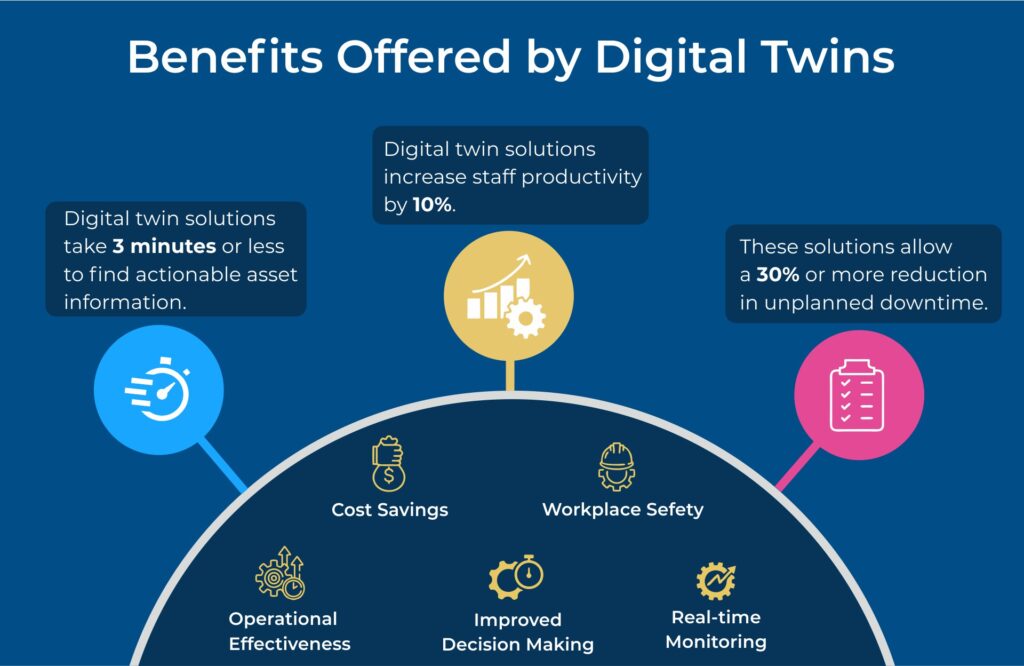In 1968, Stanley Kubrick‘s and Arthur C. Clarke‘s 2001: A Space Odyssey captivated audiences with HAL 9000, a supercomputer managing a spaceship. Over half a century later, that futuristic vision is becoming reality. Thanks to digital twins – the unsung heroes of Industry 4.0.
Digital Twins: The HAL 9000 of Industry 4.0 – Revolutionizing Efficiency and Sustainability
A digital twin is a virtual replica of a physical asset. Anything from an airplane turbine to a wind turbine blade, or even a building’s facade. Fueled by real-time data gathered through sensors and Big Data technologies, these digital representations are brought to life using artificial intelligence (AI). Besides cloud computing and machine learning. The result? A dynamic model that senses, thinks, and acts.
While the concept isn’t new. Michael Grieves, a computer engineer at the University of Michigan, discussed the potential of digital twins as early as 2002. It wasn’t until 2018 that Gartner recognized them as a top ten technology trend. Now, the impact is undeniable.
The Advantages of Digital Twins: A Game-Changer for Businesses
Deloitte and KPMG‘s 2017 reports, Industry 4.0 and the digital twin and Beyond the hype, respectively, foreshadowed the transformative power of digital twins.
A 2024 Capgemini study, Digital Twins: Adding Intelligence to the Real World revealed significant improvements. 15% increase in key operational and sales metrics. Also a 25%+ boost in system performance, and a remarkable 16% improvement in sustainability.
Revolutionizing Manufacturing
The ability to create personalized products tailored to specific customer demands will lead to unprecedented levels of customer satisfaction. Highly efficient processes, driven by real-time data analysis and simulation, will significantly reduce carbon emissions. Leading to a more sustainable manufacturing landscape.
Predictive analytics, enabled by digital twin technology, will optimize processes, leading to improved efficiency and reduced waste.

Beyond the Machine: Human Applications of Digital Twins
But the application of digital twins isn’t limited to machines. The potential for direct human application is vast and holds immense promise across various sectors.
Healthcare: Digital twins of human organs or even entire bodies could revolutionize healthcare. Allowing doctors to simulate surgical procedures, personalize treatments based on individual genetic and physiological data. Also monitor patient health in real-time. This opens the door to more accurate diagnoses, preventative care, and optimized treatment plans.
Human Performance Optimization: In sports and fitness, digital twins could analyze an athlete’s performance data to optimize training regimes. Identify injury risks, and personalize recovery plans. This could lead to significant performance gains and injury prevention.
Personalized Medicine: Digital twins could be used to model drug responses in individuals. Leading to the development of personalized medications tailored to their specific genetic makeup and reducing adverse side effects.
Ergonomics and Workplace Safety: Digital twins of workers and their environments could be used to improve workplace ergonomics. This way, preventing injuries and creating safer working conditions.
As the technology matures and data collection capabilities advance, the applications of digital twins will expand exponentially. Reshaping industries and unlocking new possibilities for human advancement.
The future is not just about smarter machines. It’s about smarter, more efficient, and healthier humans, empowered by the transformative potential of digital twins.

